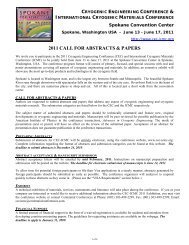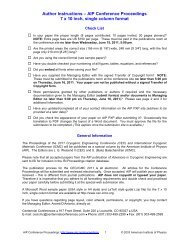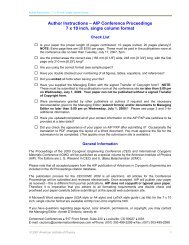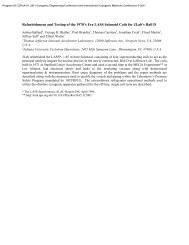CEC Abstracts in PDF format (as of 7/3/07) - CEC-ICMC 2013
CEC Abstracts in PDF format (as of 7/3/07) - CEC-ICMC 2013
CEC Abstracts in PDF format (as of 7/3/07) - CEC-ICMC 2013
Create successful ePaper yourself
Turn your PDF publications into a flip-book with our unique Google optimized e-Paper software.
<strong>CEC</strong> 20<strong>07</strong> - <strong>Abstracts</strong><br />
C2-M Instrumentation<br />
C2-M-01 Operation <strong>of</strong> Superconduct<strong>in</strong>g Digital Receiver<br />
Circuits on 2-Stage Gifford-McMahon Cryocooler<br />
R.J. Webber, V. Dotsenko, A. Talalaevskii, R. Miller,<br />
J. Tang, D. Kirichenko, I. Vernik, P. Schevchenko, D.<br />
Gupta, O.A. Mukhanov, Hypres, Inc.<br />
We have demonstrated the full operation <strong>of</strong> digital RF receivers on a<br />
Hypres-designed cryostat, which couples a Nb-b<strong>as</strong>ed superconduct<strong>in</strong>g<br />
Rapid S<strong>in</strong>gle Flux Quantum (RSFQ) chip to a commercially available<br />
100 mW 4 Kelv<strong>in</strong> Gifford-McMahon cryocooler. The electrical<br />
performance at clock speeds <strong>in</strong> excess <strong>of</strong> 24 GHz is described <strong>as</strong> well<br />
<strong>as</strong> the design <strong>of</strong> the electrical <strong>in</strong>terfaces with room temperature<br />
support electronics. The digital receiver chip is a 1cm x 1 cm chip<br />
compris<strong>in</strong>g ~ 11,000 Josephson junctions. With<strong>in</strong> the cryostat there is<br />
the <strong>in</strong>evitable conflict between the need to m<strong>in</strong>imize heat-leaks and<br />
the need to m<strong>in</strong>imize dissipation <strong>in</strong> <strong>in</strong>put-output leads. The me<strong>as</strong>ured<br />
cryogenic thermal and magnetic environments <strong>of</strong> the chip are<br />
discussed and their impact on performance. Reception and direct<br />
digital conversion <strong>of</strong> real signals <strong>in</strong> the HF-, VHF-, and X-bands<br />
<strong>in</strong>clud<strong>in</strong>g signals from military satellite antennae shows the potential<br />
<strong>of</strong> this system to replace large and power-hungry multiple analogue<br />
receivers.<br />
This work w<strong>as</strong> supported <strong>in</strong> part by the Office <strong>of</strong> Naval Research, the<br />
Army Small Bus<strong>in</strong>ess Innovation and Research Program and by the<br />
US Air Force<br />
C2-M-02 Level-detected characteristics <strong>of</strong> MgB2 sensor<br />
for liquid hydrogen<br />
M. Takeda, T. Akazawa, Y. Iwamoto, Kobe<br />
University; H. Kumakura, A. Matsumoto, H. Uematsu,<br />
C. Kazama, National Institute for Materials Science;<br />
H. Iw<strong>as</strong>hita, I. Kodama, Y. Matsuno, Iwatani<br />
Industrial G<strong>as</strong>es Corporation.<br />
In order to establish the storage and transportation system for liquid<br />
hydrogen, it is important to develop a high sensitive liquid level<br />
meter. A superconductive MgB2 level meter is expected to be a new<br />
one. However, a research on the level-detected characteristics <strong>of</strong> the<br />
MgB2 sensor h<strong>as</strong> not been sufficiently carried out. Thus the<br />
characteristics <strong>of</strong> the level sensor, which consists <strong>of</strong> a MgB2 wire (0.5<br />
mm <strong>in</strong> diameter, 200 mm long) made by means <strong>of</strong> powder-<strong>in</strong>-tube<br />
method, an electrical heater, and voltage/current taps, were<br />
<strong>in</strong>vestigated by us<strong>in</strong>g the liquid hydrogen optical cryostat. The<br />
l<strong>in</strong>earity, resolution, repeatability, and heater current dependence <strong>of</strong><br />
the sensor read<strong>in</strong>g with vary<strong>in</strong>g liquid levels are discussed.<br />
This work w<strong>as</strong> supported <strong>in</strong> part by Hyogo Prefecture (COE<br />
Program), Japan.<br />
C2-M-03 Cryogenic Fiber Optic Sensors B<strong>as</strong>ed on Fiber<br />
Bragg Grat<strong>in</strong>gs<br />
P.R. Sw<strong>in</strong>ehart, M. Maklad, S.S. Courts, Lake Shore<br />
Cryotronics, Inc.<br />
Fiber optic sens<strong>in</strong>g h<strong>as</strong> many favorable characteristics - a s<strong>in</strong>gle fiber<br />
can be used to <strong>in</strong>terrogate multiple sensors along the length <strong>of</strong> the<br />
fiber, fiber optic sens<strong>in</strong>g is immune to electromagnetic noise and is<br />
<strong>in</strong>herently safe for combustible liquids and atmospheres. Previously,<br />
fiber optic sensors b<strong>as</strong>ed on fiber Bragg grat<strong>in</strong>gs (FBGs) have been<br />
demonstrated for cryogenic use for both temperature and stra<strong>in</strong><br />
sens<strong>in</strong>g, but <strong>of</strong>ten little data is supplied <strong>as</strong> to the reproducibility or<br />
unit-to-unit uniformity <strong>of</strong> these sensors. Lake Shore Cryotronics h<strong>as</strong><br />
manufactured fiber optic cryogenic temperature and stra<strong>in</strong> sensors<br />
b<strong>as</strong>ed on Bragg grat<strong>in</strong>gs us<strong>in</strong>g novel packag<strong>in</strong>g techniques. The<br />
reproducibility and uniformity characteristics <strong>of</strong> the cryogenic stra<strong>in</strong><br />
sensor is reported for 295 K and 77K. The temperature response,<br />
reproducibility, and uniformity <strong>of</strong> wide range temperature sensors is<br />
reported from 20K to 480K.<br />
C2-M-04 A Commercial Ruthenium Oxide Thermometer<br />
For Use to 10 mK<br />
S.S. Courts, J.K. Krause, Lake Shore Cryotronics, Inc.<br />
The adoption <strong>of</strong> the PLTS-2000 h<strong>as</strong> given the ultra low temperature<br />
community a recognized temperature scale with which to work.<br />
However, the def<strong>in</strong><strong>in</strong>g <strong>in</strong>strument, the He-3 melt<strong>in</strong>g curve<br />
thermometer, is not well suited for transferr<strong>in</strong>g this scale. Primary<br />
thermometers are available for ultra low temperatures, namely nuclear<br />
orientation and noise thermometry, but they are statistical <strong>in</strong> nature<br />
and require long averag<strong>in</strong>g times for a s<strong>in</strong>gle me<strong>as</strong>urement limit<strong>in</strong>g<br />
their practical use. Resistance thermometers are e<strong>as</strong>y to use, provide<br />
f<strong>as</strong>t me<strong>as</strong>urements allow<strong>in</strong>g active feedback temperature control, and<br />
have extremely high sensitivities at ultra low temperatures allow<strong>in</strong>g<br />
for microkelv<strong>in</strong> level control. However, resistance thermometry for<br />
use below 50 mK requires reth<strong>in</strong>k<strong>in</strong>g the standard packag<strong>in</strong>g. Many<br />
common materials used <strong>in</strong> packag<strong>in</strong>g cryogenic sensors limit the<br />
thermal connection to the sensor thus limit<strong>in</strong>g the allowable excitation<br />
used for me<strong>as</strong>urement. This research exam<strong>in</strong>es the use <strong>of</strong> a<br />
commercially available ruthenium oxide thick film chip resistor for<br />
thermometry to 10 mK. Data w<strong>as</strong> acquired for sample sensors<br />
fabricated us<strong>in</strong>g two package styles. The temperature w<strong>as</strong> me<strong>as</strong>ured<br />
us<strong>in</strong>g a Co-60 nuclear orientation thermometer <strong>in</strong> conjunction with<br />
PTB-calibrated germanium thermometers. Resistance <strong>as</strong> a function <strong>of</strong><br />
temperature, self-heat<strong>in</strong>g and time response data are presented.<br />
C2-M-05 The Effect <strong>of</strong> Small Helium Leaks <strong>in</strong>to Low<br />
Temperature Systems<br />
J. Panek, E. Canavan, M. DiPirro, J. Francis, S.<br />
Riall, P. Shirron, NASA.<br />
Recent experience with small helium leaks (






